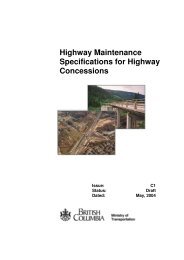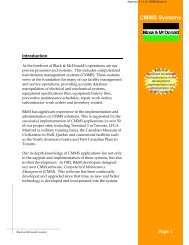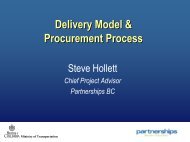The Public Sector Comparator ('PSC')
The Public Sector Comparator ('PSC')
The Public Sector Comparator ('PSC')
You also want an ePaper? Increase the reach of your titles
YUMPU automatically turns print PDFs into web optimized ePapers that Google loves.
<strong>The</strong> <strong>Public</strong> <strong>Sector</strong> <strong>Comparator</strong><br />
(‘PSC’)<br />
Canadian Council for <strong>Public</strong>-Private Partnerships<br />
Draft<br />
Vancouver - June 25 th 2003
Presentation Overview<br />
1. BC Context<br />
2. <strong>Public</strong> <strong>Sector</strong> <strong>Comparator</strong> (PSC)<br />
• What, why, & how<br />
• Issues & challenges<br />
3. Multiple Criteria Analysis (MCA)<br />
• Addressing the challenges<br />
Objective:<br />
4. Conclusions<br />
Objective:<br />
“to put the PSC in a<br />
stronger decision<br />
making context”
BC Policy Context<br />
Capital Framework Development<br />
• Examined other jurisdictions<br />
Framework Policy Approach:<br />
• Explore options - consider<br />
quantitative & qualitative dimensions<br />
• Risk based financial analysis<br />
(e.g. PSC) remains critical<br />
More recently:<br />
• Ministry of Finance & PBC<br />
commissioned Technical Paper (R.<br />
J. Adams & Associates)
Sources of Technical Guidance<br />
Partnerships Victoria (Australia), e.g.<br />
UK<br />
• <strong>Public</strong> <strong>Sector</strong> <strong>Comparator</strong> Technical Note<br />
• Technical Note & Policy Statements (e.g. PSC and Value for<br />
Money) - OGC<br />
• Green Book (cost-benefit) – HM Treasury<br />
Industry Canada<br />
• PSC – A Canadian Best Practices Guide<br />
Netherlands *
What is the PSC?<br />
“ … PSC is a hypothetical risk-adjusted costing, by the<br />
public sector as a supplier, to an output specification as part<br />
of a PFI procurement exercise” UK- Green Book<br />
“ … <strong>The</strong> PSC is the hypothetical whole-of-life risk-adjusted<br />
cost of government delivering the project” Aus- Partnerships Victoria<br />
Key/common elements in most definitions:<br />
1. Hypothetical and a forecast<br />
2. Net present value (NPV) number<br />
3. Based on life-cycle costing<br />
4. Risk-adjusted<br />
5. … if the public sector was to deliver (e.g. finance, own, operate)
Why a PSC?<br />
“ … develop and use a PSC to assess the financial aspects<br />
of value for money – and as a benchmark against which to<br />
measure the net value of alternative procurement options”<br />
BC- CAMF<br />
Key Benefits – regardless of analytical conclusions:<br />
• Brings financial & costing rigour & discipline<br />
• Requires a full life-cycle approach<br />
• Compels consideration & management of risk<br />
• Encourages bidding tension & competition<br />
• Can encourage consideration of management & delivery options
PSC - Challenges<br />
Three key considerations:<br />
1. Incorrect or confusing use of the term PSC<br />
2. Technical complexities in constructing the PSC<br />
3. Application - ‘Apparent’ simplicity can be misleading<br />
• e.g. doesn’t easily accommodate non-financial and nonquantifiable<br />
factors critical to decision-making<br />
Most literature acknowledges limitations<br />
• … however, it doesn't necessarily offer clear solutions
PSC – terminology confusion<br />
x the public sector (reference) “project” displaced by a P3<br />
x the “scenario” (i.e. life-cycle costs) associated with the project<br />
the risk adjusted PV financial costing of that scenario<br />
x the overall “value” of that scenario<br />
• i.e. including financial & non-financial factors<br />
x the comparison process itself<br />
x the “shadow-bid” or the expected P3 annualized payment
PSC<br />
Cost<br />
in<br />
$M<br />
Other Decision Factors (outside PSC): e.g.<br />
• Service quality & market innovation<br />
• Industrial relations<br />
• Broader economic benefits<br />
• <strong>Public</strong> Interest<br />
• Access, safety, privacy<br />
Build<br />
Competitive Neutrality<br />
NPV<br />
Design<br />
Risk (Retained + Transferred)<br />
Maintenance<br />
Net Operating Costs<br />
Capital Improvements<br />
1 2 3 4 5 6 7 8 9 … t-1 t<br />
discounted cost/cash flow<br />
Time<br />
in<br />
Years
$ (NPV)<br />
Tax<br />
Self -insurance<br />
Policy or<br />
regulation<br />
Base demand<br />
Geotech<br />
Competitive Neutrality<br />
(Hidden/Assumed Costs)<br />
Transferable<br />
Risk<br />
Shared Risk<br />
Retained Risk<br />
Raw<br />
PSC<br />
(Baseline Costs)<br />
PSC<br />
Operating risk<br />
Variable demand risk<br />
Maintenance risk<br />
Security risk<br />
Technology risk<br />
Direct Costs, e.g.<br />
Capital<br />
Operating<br />
Maintenance<br />
Decant/move-in<br />
Indirect Costs<br />
Admin & overheads<br />
Revenues<br />
Third party , Land sales
Expected Cost<br />
Planning<br />
Affordability<br />
Market<br />
Transferable<br />
Risk<br />
+ additional<br />
retained risk<br />
Competitive<br />
Neutrality<br />
Raw<br />
NPV<br />
of<br />
Payments<br />
NPV<br />
of<br />
Payments<br />
NPV<br />
of<br />
Payments<br />
PSC<br />
Retained Risk<br />
Retained Risk<br />
Retained Risk<br />
Retained Risk<br />
PSC<br />
Shadow Bid<br />
(Expected P3 bid)<br />
P3 Bid 1<br />
P3 Bid 2
Steps in Building & Refining the PSC<br />
Planning<br />
Strategic Options<br />
Analysis<br />
Is preferred option affordable?<br />
Service outputs @ strategic level<br />
Is a PSC relevant/warranted?<br />
Preliminary costs & risks<br />
Preliminary PSC & shadow bid<br />
Business Case<br />
Approval<br />
Implementation<br />
EOI<br />
Business case fully developed<br />
Detailed output specs<br />
Detailed PSC & shadow bid<br />
Procurement team assess<br />
risks/costs & assumptions<br />
Refine PSC as required<br />
Planning<br />
RFP<br />
(issued to market)<br />
Refine PSC if changes: e.g. to<br />
final scope, output specs., risk<br />
Award Decision<br />
Compare bids to shadow & PSC<br />
Fairness - PSC not refined to<br />
capture market innovations<br />
Market
PSC - key technical issues<br />
Appropriate Discount Rate<br />
Risk calculations<br />
• e.g. complexity, what & how to calculate<br />
Optimism bias<br />
Tax considerations & treatment<br />
Efficiency Assumptions<br />
• e.g. translation of PSC to a shadow bid<br />
Sensitivity Analysis/Switching Analysis
PSC – key application issues<br />
Requires “like-to-like” comparisons<br />
Does not ensure addressing affordability<br />
<strong>Public</strong> sector delivery option may not be only,<br />
or best benchmark<br />
Quantitative/financial costing/benchmark only<br />
• Value for money project decisions based on broader<br />
parameters, e.g.<br />
• Qualitative project factors (e.g. in planning)<br />
• Qualitative aspect of P3 bids (i.e. market response)
PSC – key application issues (cont’d)<br />
Market<br />
Innovation<br />
Environmental<br />
Third<br />
Party<br />
Revenue<br />
Economic<br />
Development<br />
Direct<br />
Operating<br />
Costs<br />
<strong>Public</strong><br />
Interest<br />
Issues<br />
Industrial<br />
Relations<br />
Maintenance<br />
Costs<br />
First<br />
Nations<br />
Demand<br />
Growth<br />
Hidden<br />
Costs<br />
Social &<br />
Economic<br />
Goals<br />
Indirect<br />
Costs<br />
Levels of<br />
Service<br />
Delivered<br />
Operating<br />
Risk<br />
Project<br />
Risks<br />
Policy<br />
Flexibility<br />
Direct<br />
Capital<br />
Costs<br />
Tax<br />
Treatment
PSC – key application issues (cont’d)<br />
“… using a PSC can inform a decision about value-for-money, but<br />
it cannot be relied upon to provide an inflexible and simple answer<br />
to the question” UK, OGC Technical Note 5<br />
“… ensure that value for money decisions are not based on a<br />
one-dimensional comparison of single figures” UK, Auditor General<br />
PSCs focus solely on relative costs, yet often used incorrectly as a<br />
comprehensive pass fail test. Decisions need to be based on a<br />
realistic, systematic and comprehensive analysis of benefits &<br />
risks as well as costs. PSC should be just one of the factors …<br />
UK, Committee of <strong>Public</strong> Accounts, June 19 2003
• <strong>Comparator</strong> (benchmark) needed - MCA accommodates more than one<br />
MCA - addressing the challenges<br />
Multi-Criteria Analysis (MCA) - linked to:<br />
• “Comprehensive Matrix Approach”, MAE & “multi-attribute analysis”<br />
Key output is a table of quantitative & qualitative criteria:<br />
• Compare incremental changes among options - across criteria<br />
• ‘Decision process’ not a simple decision rule<br />
• i.e. not just a risk-adjusted NPV estimate (PSC)<br />
• Enables explicit & transparent trade-offs between options & criteria<br />
• When appropriate, ‘PSC’ can be a key financial component
Simplified MCA Matrix<br />
GOALS/<br />
CRITERIA<br />
Service<br />
Quality<br />
‘Do Minimum’<br />
Option<br />
adequate<br />
(Planning)<br />
Preferred<br />
Option<br />
(<strong>Public</strong> Delivery)<br />
benchmark<br />
Preferred<br />
Option<br />
(P3 Shadow Bid)<br />
best<br />
(Market)<br />
P3 Bid<br />
(Preferred Bid)<br />
best<br />
Strategic<br />
Fit<br />
good<br />
best<br />
good<br />
good<br />
<strong>Public</strong><br />
Interest<br />
good<br />
best<br />
best<br />
best<br />
Other Market<br />
Innovation<br />
poor<br />
n/a<br />
best<br />
best<br />
Social &<br />
Economic<br />
poor<br />
good<br />
best<br />
best<br />
Financial<br />
(e.g. riskadjusted<br />
NPV)<br />
$160m<br />
$220m<br />
PSC<br />
$215m<br />
$220.5m
Business Case<br />
• Planning Context<br />
• Program/Service<br />
• Implementation Plan<br />
• etc.<br />
MCA<br />
PSC
Other Considerations<br />
Linkages of MCA criteria to procurement process?<br />
Disclosure of MCA (& PSC) – during procurement:<br />
• Develop case-by -case approach:<br />
• Disclosure to bidders<br />
• Disclosure to public<br />
• Key considerations to weigh:<br />
• Level of disclosure<br />
• Transparency & accountability<br />
• Effect on competition<br />
• Negotiating position<br />
• Commercial interests of bidders & economic interests of province
MCA - conclusions<br />
BENEFITS …<br />
Broader focus on “VfM”<br />
Evaluate range of options<br />
Robust, flexible & transparent<br />
Allows explicit trade-offs<br />
among criteria<br />
Can build in financial analysis<br />
“PSC” in a stronger decisionmaking<br />
context<br />
<strong>The</strong>oretically sound<br />
CAUTIONS …<br />
Critical to build in principles<br />
from benefit-cost & financial<br />
analysis<br />
Need well defined &<br />
appropriate criteria<br />
Can be more complex than<br />
simple financial analysis<br />
Not as widely taught & applied<br />
as other appraisal methods<br />
(e.g. benefit-cost)
Conclusions<br />
1. PSC can be a valuable tool & guide, but only one element<br />
2. Use incremental MCA as part of business case &<br />
decision-making framework<br />
• PSC in the context & a component of MCA<br />
3. Address affordability<br />
4. Develop and refine a PSC as long as public delivery is a<br />
realistic option<br />
5. Training & expertise required in PSC, MCA and risk<br />
assessment

















